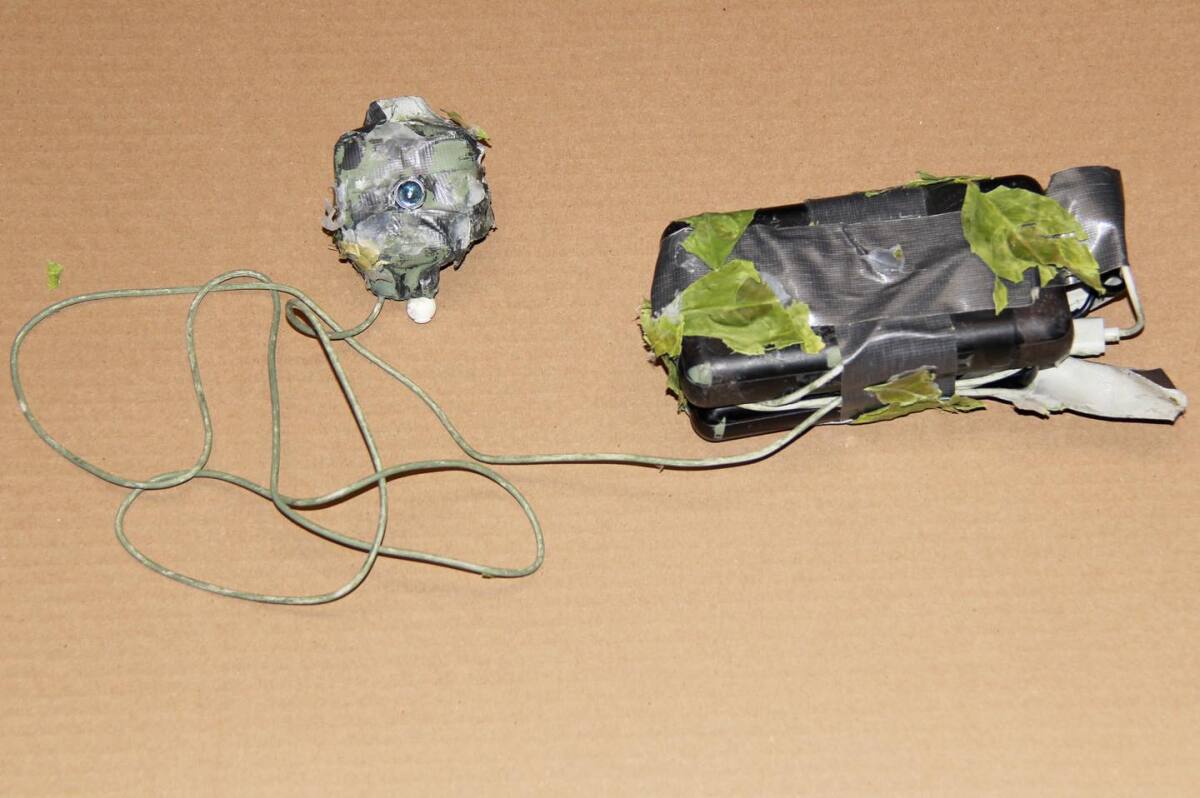Burglars are hiding cameras in Southern California yards: Tips for protecting yourself

- Share via
In an era when everybody is staring at their phones, burglars are banking on people failing to notice the hidden camera in their front yard.
Residents across Southern California have discovered small video cameras hidden near their homes, crudely assembled surveillance devices stashed among shrubs or in planters, wrapped in plastic green leaves and often attached to a battery pack. The cameras are stashed by burglars who want to learn the schedules of their potential victims.
The scheme is not unique to any one city or neighborhood in the United States, according to law enforcement.
In Alhambra on Monday evening, a resident found a camera hidden in a bush pointed at a nearby home in the 1900 block of South Primrose Avenue, the Alhambra Police Department announced in a Facebook post. The resident whose house was in the camera’s sights had received a call from their home security company earlier in the day saying that someone had tried to open their kitchen window.
There were no additional details about the investigation. But the incident speaks to a growing trend: While residents have gone high-tech to protect their homes, so too have criminals.
The secret stakeout
For decades, police agencies have recommended that residents trim the hedges around their homes so they can have a clear view of their surroundings and minimize hiding spots for intruders. Good outdoor lighting is also advised to avoid becoming an easy target for burglars.
But now police agencies are warning people to look out for camouflaged packages in their yards.
A thief can stake out a neighborhood by driving through the area or posing as a salesperson to see when residents are home, Alhambra police note in an advisory. But a hidden camera allows a criminal to watch a home without having to stick around the neighborhood. Then, they can review the video later.

“It could be any type of camera that is digital and wireless. It could be cheap; it could be expensive,” said Sgt. Vahe Abramyan of the Glendale Police Department. “You can go on Amazon or go to Best Buy to get one.”
The cameras that have been discovered and shared by police agencies in recent months are about a quarter the size of a typical mobile phone and usually are attached to a portable battery bank to keep the device charged. Most of the cameras use a memory card, but others are connected to a mobile hot spot that allows the device to send data remotely, according to Abramyan.
“The suspects will go back and retrieve their cameras before they commit a burglary,” he added.
Rare, but troubling
Instances of camouflaged cameras being found are rare but have occurred multiple times around the Southland in the last few months.
A Garden Grove resident found out in late May that a camera had been hidden in a neighbor’s bush and was pointed at her home. It was unclear who left the device.
The homeowner told news station KTLA that the neighbor thought they saw some trash in their bush but instead found a bag with a camera and a battery pack inside — and it had been trained on her home. She said the incident was unsettling.
In Glendale, police arrested four men after they were pulled over during a traffic stop on the evening of May 20. The men were leaving a cul-de-sac in a residential neighborhood. Their headlights were off. During a vehicle search, officers found a video surveillance camera with a portable battery charging pack in a shopping bag. The camera and battery pack were wrapped in plastic green leaves, police said in a news release, and officers found a planter on the street with freshly disturbed dirt that they believed was where the suspects retrieved the camera.
Officers also found in the car several boxes meant to hold jewelry. There was also a construction hard hat and a vest, which could be used to get near a home without drawing attention, police said.
The men were identified as Bryan Martinez Vargas, 28; Jose Antonio Velasquez, 28; Edison Arley Pinzon Fandino, 27; and Luis Carlos Moreno, 29, according to police, and they were arrested on suspicion of conspiracy to commit burglary. Police said the men were part of a “burglary tourism” ring. The groups, made up of Chilean and Colombian nationals, utilize surveillance equipment as part of their tactics to break into homes in affluent neighborhoods, the Los Angeles County Sheriff’s Department said in an advisory.
Vargas was previously involved in a high-speed pursuit when Glendale police responded to reports of a residential burglary call in the Crescenta Highlands neighborhood, authorities said.
In police dash-cam video, a man police say is Vargas can be seen jumping out of a vehicle as it comes to a stop on a freeway exit. Police observed someone throw several objects out of the vehicle during the pursuit, including a device used to disrupt Wi-Fi signals, according to the department.
Wi-Fi jammers are used by burglars to disrupt home surveillance equipment that typically connect over a wireless internet connection, Abramyan said. Those jammers could potentially disable a doorbell camera that is not hardwired into the home’s electrical system.
It’s illegal to be in possession of a jamming device but not illegal to sell them, Abramyan said. The jammers are not difficult to purchase online.
Don’t get complacent
Incidents of hidden cameras being discovered are isolated but have grabbed media attention, said security consultant Rick Navarro. And that’s a good thing, he said.
“These ... are good conversations for people to have,” said Navarro of ACS Home Security. “You don’t want to see people becoming complacent with their home security.”
In the security industry, customers oftentimes call ACS after the break-in has already happened, Navarro said.
“That onus falls on the individual to protect their property,” he said, “because it really is a cat-and-mouse game.”
But there are steps you can take to protect yourself. Here are tips from the L.A. County Sheriff’s Department and the Los Angeles Police Department:
- Make it a practice to regularly inspect around the exterior of your home, and be aware of any suspicious activity in the neighborhood.
- If you discover a hidden camera, immediately call your local police agency to document and collect the device.
- Shift from wireless to wired. Anyone who wants to deter Wi-Fi jamming can ask their internet provider or an electrician to hardwire their burglary alarm system, connecting it to their router via cables.
- It may be wise to put electronic trackers inside some valuables. The LAPD recommends Apple Air Tags or similar trackers, which can be placed inside an object — like a purse or a jacket — and tracked via a smartphone.
- Protect your circuit breakers. Residents can invest in a padlock for their electrical circuit boxes to deter easy access for burglars who want to interfere with the alarm system.
- Make it harder to break in. The LAPD recommends that anyone with a sliding door place a metal bar on the bottom tracks to block it from opening, and install motion sensor lighting for when nobody’s home.
More to Read
Sign up for Essential California
The most important California stories and recommendations in your inbox every morning.
You may occasionally receive promotional content from the Los Angeles Times.











